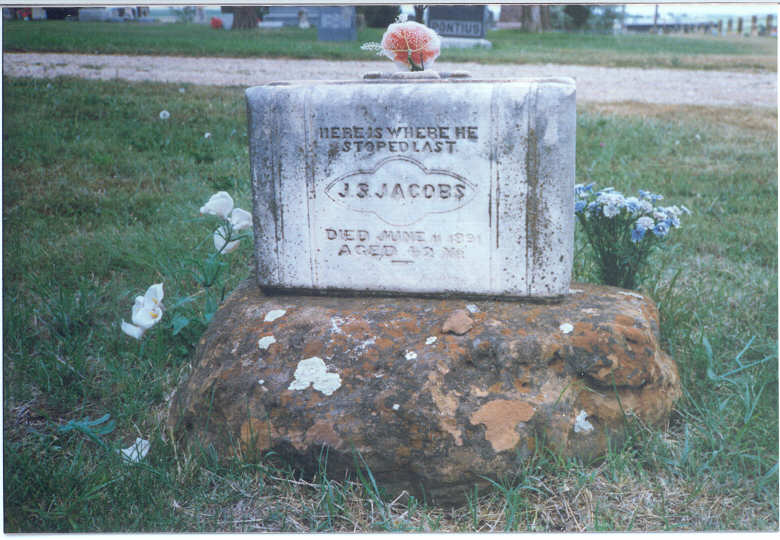The Suitcase Tombstone

Lincoln Sentinel-Republican, July 5, 1984
"Lincoln's suitcase tombstone featured in popular magazine"
Once again Lincoln citizens have thumbed through a current periodical and found that the suitcase tombstone which marks the grave of the turn of the century traveling salesman at Lincoln Cemetery has been featured in the "news."
A story by Barbara Brackman in KANSAS! Magazine published in June is entitled "Going in Style." The article, accompanied by John Gary Brown photos taken at several Kansas graveyards in addition to the Lincoln cemetery, tells a bit about the J.S. Jacobs marker.
Ms. Brackman relates that Jacobs was a salesman who died here in 1891, "leaving behind" a limestone replica of his sample case. She quoted the epitaph, "Here is where he stoped [sic] last," which, she wrote succinctly, "is a testament to the fact that the anonymous stone carver's artistic skills were superior to his spelling."
In her book, "Lincoln ' That County in Kansas," the late Dorothe Tarrence Homan told that the "anonymous" stone carver was actually one Henry Sahlmann.
Lincoln County folklore has it that Jacobs became ill and died at Lincoln while on a stopover at the early day Windsor Hotel. And that, since his family was never located, local business proprietors hired a stone carver to prepare the headstone so that the salesman's final resting place would not go through the ages unmarked.
True, it is a popular legend here; however, the truth of the matter is a different story.
The late Lincoln attorney, Walter Urban, did considerable sleuthing a year or two ago which put to rest the poignant tale of the salesman.
Mr. Urban learned that J.S. Jacobs, who died at age 42 on June 11, 1891, was neither orphaned nor estranged from his family. Rather, Mr. Urban discovered Jacobs' family lived right here at Lincoln. As a matter of record, his mother and his father are buried along side of their traveling salesman son in the same cemetery lot ' a lot that was purchased by the father.
With an assist from Bob Lewick of Hall Furniture and Mortuary who delved through records dating back to 1871 which show lot purchases at the cemetery, it was found that the salesman's father bought the lot of April 26, 1886, and that he paid for the purchase on Oct. 20, 1891, the year of J.S.'s death.
Further, Lewick took a shovel out to the cemetery, and digging a shallow trench in the top soil, ascertained exactly where the parents' graves are located on the lot. This findings resulted from a simple deduction of which topsoil was the original and which was not ' and gave evidence that two graves had indeed been dug there in addition to the one bearing the stone.
The remains of Henry and Mary Jacobs lie to the north of their salesman son's grave.
Also the elder Jacobs' daughter, Nannie Jacobs Strange, wife of Alfred Strange is buried in Lincoln Cemetery, records show, although her grave is not in the same lot as her parents and sibling.
Mrs. Strange died at a young age, leaving two children and her husband. He later remarried and the family left Lincoln, says Edna Gislar. Mrs. Gislar and her sister, Selma Webb, are the daughters of Alfred Strange's sister.
These facts and accounts of Jacobs family members' obituaries found on microfilmed newspapers at the local library, refute the legend that the salesman was without family. The old newspapers related, too, that a brother came from Nebraska for the salesman's funeral, the late Mr. Urban said, and that he had visited his parents before returning to Nebraska.
The late attorney did not dispute that part of the legend that credits Lincoln businessmen with passing the hat to finance the suitcase marker. The elder Jacobs were not without means; they left an estate at their deaths in 1901.
Mr. Urban supposed that the parents simply did not believe in putting up headstones, and that J.S.'s kindly local associates did indeed cause the marker to be made and placed at his grave.
Of course, knowing the facts does not necessarily preclude future generations of Lincoln-born from hearing the folklore surrounding the unusual gravestone. Legends die hard.
Ripley's Believe or Not:
Lincoln County News, June 29, 1933Ripley of believe-it-or-not fame selected the tombstone of J.S. Jacobs in the Lincoln cemetery for one of his astonishing statements last week. The cartoon appeared in the Wichita Beacon.
The stone is in the form of a dummer's sample case, remarkably well cut even to such details as the keyhole. It bears the following inscription, spelling and all:
Here is where he
Stoped Last
J.S. Jacobs
Died June 11, 1891
Aged 42 yr.
The stone is located near the south side of the cemetery and is made of marble, mounted on a rough sandrock base. The stone is the work of H. Sahlmann, an expert tombstone cutter and bricklayer, much of whose work may be seen in the older section of the cemetery.